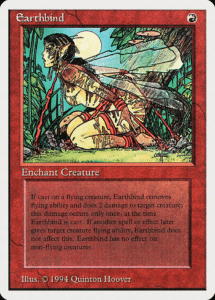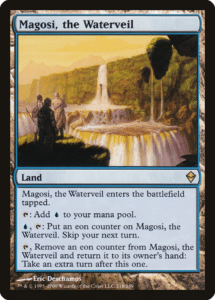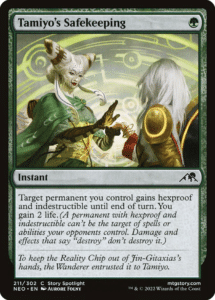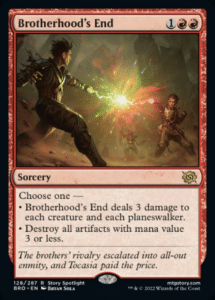We cover a lot of MTG finance news This game has become incredibly expensive, and honestly, the fact that every MTG card has its own little stock market-like following is insane. While we’re among the first to tell you when these spikes happen, what happens when all the hype dies down? Here, we’ll look at some of the most significant spikes we have covered over the year and how they’ve leveled out. There’s a bit of a spoiler in the title with this one: most of these have seen a dip in price!
The Censorship Spike

Perhaps the most dramatic sudden MTG finance spike that happened this past year was that of Earthbind. This card suddenly got a massive spike near the beginning of October due to Wizards of the Coast announcing what may be the most infamous product in all of MTG history: the 30th Anniversary Edition.
There were many problems with this product, but we won’t talk about those here. Among them, however, was a modernization of MTG’s Beta set. As a result of this modernization, Earthbind has declared a card that will not be reprinted. While there is no confirmation as to why this is, besides Earthbind not fitting the modern image of the game, many were pretty certain that the card art was too sexual to see a reprint.
The realization that this suggestive artwork of Earthbind will likely never be reprinted caused a massive spike for all of the copies of it that have the artwork. The Unlimited version of this card spiked from $5 to $30 over a few days. The most expensive version of Earthbind from Alpha saw the average price of a Near Mint copy rise from about $300 to $5-600. Still, an incredibly small sample size makes trends for this particular version of the card unreliable. The cheapest version of Earthbind rose from less than a dollar to about $6.
These Earthbinds have retained some amount of value from their October spike, but they’re also falling off. The Revised version (or cheapest) of Earthbind has fallen the hardest, gradually hitting $1.30 over the last few months. The Unlimited version has kept up much better, only falling for $20 for a near-mint copy from its $30 high point. That said, worse condition versions of this card can be purchased for less than $10. In summary, Earthbind has kept some value from its initial spike, but trends suggest that value may be temporary for more common copies of the card.
Magosi, the Waterveil

While the spike that hit the most prominent headlines was related to Magic 30, this particular MTG finance diamond in the rough saw a massive increase in interest after an infinite combo with the card was discovered, with some new cards released in the MTG Warhammer set. If you’re interested in reading about the infinite combo, we covered it here.
Once word about the infinite combo started spreading across the MTG community, Magosi, the Waterveil saw an incredible spike from less than a dollar to $5 over a week. While some of the players interested in this card actually wanted to play them, it became clear from successful sales that many people were speculating on this card. It makes sense since the card is from an incredibly old set and only has one printing.
Those who got in on the ground floor managed to more than quintuple their profit. Magosi is still standing strong according to TCGplayer’s market averages, but recent sales tell a different story. Magosi is now selling for around $1.50, which means that the card still kept triple its original value, but players who bought in at higher market values trying to make a profit might be disappointed. We warned those interested that this price hike might be artificial.
Tamiyo’s Safekeeping

What the heck happened to this Standard common to cost $10!? To be precise, foil copies of Tamiyo’s Safekeeping spiked incredibly hard in mid-August. At the time, this card saw both Standard and Commander play primarily, while Pioneer and Modern were experimenting with it. The biggest reason why this foil Common spiked so heavily was because the card was surprisingly scarce. Generally, the introduction of Collector Booster packs has killed foil multipliers for rarer cards, but these Collector Booster packs simply do not have a lot of Common cards in them.
While Tamiyo’s Safekeeping still has a startlingly large foil multiplier, the card is no longer worth $10. The card now goes for about $6, which is still much more than its pre-spike price of $1.50 near the end of May. This card even shows signs of rising in price once again.
Brotherhood’s End

We’ll end off with a card that was released more recently. Brotherhood’s End still appears to be in its spike phase, and it’s seeing play in all kinds of different formats. You can get into the specifics in this article we wrote here.
Brotherhood’s End debuted at about $2.25 and has risen to $5 for the end of the year. That said, Brotherhood’s End is currently selling for $6, with some foil versions selling for $10. This doesn’t match market data at all, suggesting that Brotherhood’s End’s spike may not be over anytime soon.
Spike to Finding Price Points
Looking at some of the largest price spikes covered on this site in the last year showcases that after a card hits a certain point, it will begin to level out and find a price point. Most of the time, larger spikes seem to retain some of their value, but if the card is not constantly at the center of the MTG market, it will lose some market value. This is best shown by the Earthbind printing. This card saw a massive price spike initially, but the cheaper versions of the card have almost reverted to their initial price point.
The trick, therefore, becomes figuring out where the zenith of a card’s price spike is. It’s easy to look back after the fact and say, ‘you shouldn’t have bought that card then. It was too expensive,” but in the moment of the spike, unless you get a whiff of the card’s demand being satiated, it can be challenging to figure out when exactly the spike will stop. That said, if you’re in no rush to own cards undergoing massive spikes and you believe you missed out on some of the cheaper prices, the best plan might just be to wait it out.

